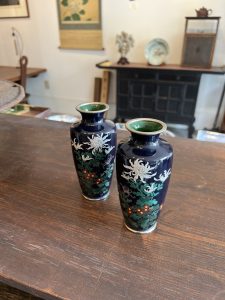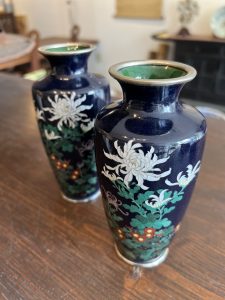古美術を深堀る【七宝焼】(愛知県名古屋市千種区姫池通 骨董買取 古美術風光舎)
2024.06.22
みなさまこんにちは、スタッフYでございます。
ここ名古屋梅雨入りまして、この湿度でいよいよエアコン生活が始まりました。つけたら最後、もうなしではいられなくなってきまして。なんだか消した途端「不快」が襲ってきます。もう少し我慢した方がよかったのか…。と、ちょっと悩みましたが、もうONしてしまいましたので、後戻りはできませんね笑。しばらくお世話になることに致しましょう。
そんなくだらない自分の話はおいておいて、最近、古美術を深堀るシリーズを始めているのですが、本日からはここ店舗にも数点あり、個人的にも大好きな【七宝焼】を深堀ってみたいと思います。
どうぞお付き合いくださいませ。

1.七宝焼とは
七宝焼きは、紀元前の古代エジプトを起源とする世界的な伝統工芸で、日本には奈良時代頃に近代的な技術が伝わってきたと考えられています。金や銀、銅、鉄などの金属を素地とし、釉薬を塗って750~950℃で焼成製したもであります。
琺瑯製のキッチン用バットや鍋やバットといった調理器具や食器の他、看板や道路標識などにも利用されており、実は看板や道路標識などにも利用されております。
2.七宝とは
七宝焼の「七宝」の意味は、七宝焼が日本に伝来して以降、時代とともに変遷してきたと考えられています。
古くは仏教の経典に登場する七種の宝 に由来し、金、銀、瑪瑙(美しい模様を持つ鉱石)、珊瑚、瑠璃(青い宝石)、玻璃(水晶)、硨磲(シャコガイの殻)の七つの宝物を表し、この七つの宝物と同じくらいの美しさを持つ焼き物ということで、七宝焼という呼称が定着しました。
3.七宝焼の魅力
七宝焼の魅力はその鮮やかな模様と、釉薬を焼成することで生まれる煌びやかな風合いなのですが、さまざまな技法があるのが特徴で、熟練のテクニックだけでなく初心者でも簡単にオリジナル作品を作れてしまう親しみやすさもまた七宝焼の大きな魅力であります。
有名なところで古代エジプトでは、ツタンカーメンの黄金のマスクの冠部分 に七宝焼きの技法が用いられていたといわれていますが、現代では壺をはじめブローチやペンダント、ピアス、イヤリングなどのアクセサリーもあり、その歴史や用途が幅広い。
また、七宝焼きはいわゆるエナメル質といわれるガラス質で表面が覆われているため、保存性が高いのも特徴の一つであり、素焼きの陶器や鉄器などは、表面に傷がついたりカビが繁殖したりと、保存面での問題がありますが、七宝焼きはこうしたトラブルに強く、いつまでも風合いが変わらない安定感があります。
ただし、ガラス質なので、衝撃などによるヒビ割れには気をつけなければなりません。
4.七宝焼の歴史
まさにホーローそのものを表していますが、1450年代以降の中国で作られた七宝焼は景泰藍 といわれ、中国工芸として特に高く評価され、西洋でも七宝焼は紀元前から存在していることがわかっております。そこから中国や日本同様に発展してきました。
西洋、中国、日本の技法の呼称はそれぞれ異なりますが、いずれも同様の技法が受け継がれているのがおもしろいところであります。
5.日本における七宝焼の歴史
日本における七宝焼きには、奈良県生駒郡斑鳩町の藤ノ木古墳から金銅製鞍金具の副葬品が出土しており、これは古墳時代のものと見られることから、日本に七宝焼の技術が伝来する以前にも、原始的な七宝焼が作られていたことを示しています。日本に伝えられた時期は想像していたより古いようですね。
しかし、日本における七宝焼きの技法が洗練されたのは意外にも近代のこと。天保4年(1833年)に愛知県名古屋市の陶芸家である梶常吉が七宝焼きの技法を発見して以降、愛知県を中心に七宝焼きの技法が急速に広がったといわれております。
さらに、日本の七宝焼きが世界にはじめて知られたのは慶応3年(1867年)のパリ万博へ出品された時で、多数の日本人作家が受賞することで日本の七宝焼きが世界から注目されるようになりました。平成7年(1995年)には経済産業省により尾張七宝が日本の伝統的工芸品として指定され、平成14年(2002年)には東京都が指定する東京の伝統工芸品41品目の一つに東京七宝が選ばれております。
本日は、七宝焼の歴史などについて簡単に述べてまいりました。
次回は、その技法へと深堀していきたいと思っております。
それではごきげんよう。

Hello everyone, this is Staff Y.
The rainy season has started here in Nagoya, and with the humidity here, we have finally started to live with air conditioners. Once I turn on the air conditioner, I can no longer live without it. As soon as I turn it off, I feel “uncomfortable”. I wondered if I should have held out a little longer…. I was a little worried, but now that I have turned it on, there is no turning back. I will turn it on without hesitation.
Putting such trivial talk about myself aside, I have recently started a series of articles on antiques, and from today, I would like to delve deeper into cloisonne enamel ware, which we have several of here at the store and which I also personally love.
Please bear with me.
What is cloisonne enamel ware?
Cloisonne enamel ware is a worldwide traditional craft that originated in ancient Egypt in B.C., and it is believed that modern techniques were introduced to Japan around the Nara period (710-794). It is made of gold, silver, copper, iron, and other metals, coated with glaze, and fired at 750 to 950℃.
Enameled kitchen vats, pots, bats, and other cooking utensils and tableware are also used for signboards, road signs, etc. In fact, they are also used for signboards and road signs, etc.
2. What is cloisonne enamel ware?
The meaning of the word “cloisonne” in cloisonne enamel ware is thought to have changed over time since cloisonne enamel ware was introduced to Japan.
The term “cloisonne” is derived from the seven treasures of the seven treasures mentioned in Buddhist scriptures and represents the seven treasures of gold, silver, agate (ore with beautiful patterns), coral, lapis lazuli (blue gemstone), boli hari (crystal), and giant clam shell (shell of the giant clam), and refers to pottery that is as beautiful as these seven treasures, The name “cloisonne enamel ware” has taken root because the pottery is as beautiful as these seven treasures.
3. the charm of cloisonne enamel ware
The charm of cloisonne enamel ware lies in its vivid patterns and the shimmering texture created by firing the glaze.
Famously, the cloisonne enamel ware technique was used in ancient Egypt for the crown of Tutankhamen’s golden mask. Today, cloisonne enamel ware has a wide range of history and uses, including vases, brooches, pendants, earrings, and other accessories.
Another characteristic of cloisonne enamel ware is that its surface is covered with what is called enamel, a glassy substance, which makes it easy to preserve. Unglazed pottery and ironware have preservation problems such as surface scratches and mold growth, but cloisonne enamel ware is resistant to these problems and the texture will always Cloisonne ware, however, is resistant to such problems and has a stable texture that does not change over time.
However, since cloisonne enamel ware is made of glass, it is important to be careful of cracks caused by shocks.
History of Cloisonne ware
As mentioned earlier, cloisonne enamel ware is said to have originated in ancient Egypt in B.C., and the manufacturing technique was born in the Middle East. Later, the technique was introduced to China via the Silk Road, and in China, cloisonne enamel ware is written as “enamel” and read as “farang. It seems that “enamel” came from here.
Cloisonne enamel ware made in China after the 1450s is called “Jing Tai Lan” and is highly regarded as a Chinese craft, and it is known that cloisonne enamel ware has existed in the West since BC. Cloisonne enamel ware has developed from there as well as in China and Japan.
It is interesting to note that although the names of the Western, Chinese, and Japanese techniques differ, the same techniques have been handed down from one generation to the next.
History of Cloisonne ware in Japan
Cloisonne enamel ware in Japan has a gilt-bronze saddle clasps as a secondary burial object excavated from the Fujinoki Tumulus in Ikaruga-cho, Ikoma-gun, Nara Prefecture, which appears to date from the Kofun period, indicating that primitive cloisonne enamel ware was made even before the technique was introduced to Japan. It seems that the time of its introduction to Japan is older than we had imagined.
However, it was surprisingly in modern times that the technique of cloisonne enamel ware in Japan was refined. In 1833, Tsunekichi Kaji, a potter in Nagoya City, Aichi Prefecture, discovered the cloisonne enamel ware technique, and it is said that the technique spread rapidly mainly in Aichi Prefecture.
Furthermore, Japanese cloisonne enamel ware first became known to the world in 1867 when it was exhibited at the World Exposition in Paris, and many Japanese artists received awards, bringing Japanese cloisonne enamel ware to the attention of the world.
In 1995, Owari cloisonne enamel ware was designated as a traditional Japanese craft by the Ministry of Economy, Trade and Industry, and in 2002, Tokyo cloisonne enamel ware was selected as one of the 41 traditional crafts in Tokyo designated by the Tokyo Metropolitan Government.
Today, I have briefly described the history of cloisonne enamel ware.
Next time, I would like to go deeper into the techniques of cloisonne enamel ware.
Good bye.
*******************
ご実家の整理やお片付けなどをされている方のご相談などが多くございます。
お片付けなどくれぐれもご無理のないようになさってくださいませ。
風光舎では古美術品や骨董品の他にも絵画や宝石、趣味のお品など様々なジャンルのものを買受しております。
お片付けをされていて、こういうものでもいいのかしらと迷われているものでも、どうぞお気軽にご相談下さいませ。
また風光舎は、出張買取も強化しております。ご近所はもちろん、愛知県内、岐阜県、三重県その他の県へも出張いたします。
まずは、お電話お待ちしております。
愛知県名古屋市千種区姫池通
骨董 買取【古美術 風光舎 名古屋店】
TEL052(734)8444
10:00-18:00 OPEN

